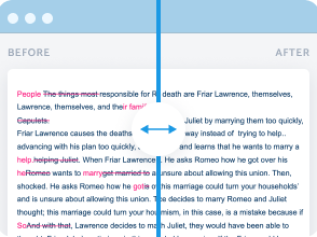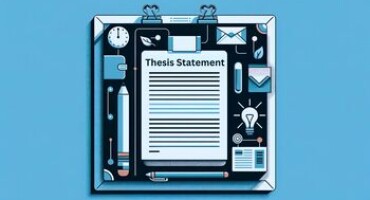How to Write A Reaction Paper: Guide For College Students
Table of contents
- 1 First Things First: What Is A Reaction Paper?
- 2 What About The Reaction Papers Format?
- 3.1 Introduction
- 3.2 Thesis Statement
- 3.3 Body Paragraphs
- 3.4 Conclusion Paragraphs
- 3.5 Citations
- 4 Tips for Writing A Reaction Paper Effectively
- 5 Things to Avoid While Writing a Reaction Paper
In most educational settings, teachers and instructors need to assess the abilities of their students. A common method applied to do that is the use of essays or academic assignments. Papers and essays allow students to showcase their skills and understanding of a particular idea and subject.
One type of essay that is often used in the form of a home task is a reaction paper. This usually requires the students to read and analyze a piece of literature or article. Then write a response that is a reflection of their thoughts and emotions on that material.
Students are usually asked to write a reaction paper to learn how to engage in a meaningful way while articulating their thoughts properly. If you are required to write a reaction paper, it’s important to understand the purpose and thoughtfully approach the assignment.

First Things First: What Is A Reaction Paper?
A reaction paper, also known as a response paper or response essay, is a unique essay requiring a critical perspective in response to another text. It is commonly assigned by teachers and college professors to evaluate students' reading comprehension abilities.
The purpose of a reaction paper is to provide an analysis and interpretation of the text and to express the writer's personal opinions and reactions to it. Each reaction paper uniquely expresses the composer's thoughts, making it a valuable tool for developing critical thinking skills.
The process of writing a reaction paper includes two parts. Here is how to write a reaction paper.
- The analysis of the text,
- And the correct expression of your personal opinion or response.
Reaction papers and research papers serve different purposes and require distinct approaches. Reaction papers involve providing a critical response and personal opinion, while research papers involve conducting thorough research and presenting objective findings. Confusing the two can lead to errors in writing. Reviewing a guide on how to write a research paper can help differentiate between the two and understand their unique requirements.
It´s also important to learn to differentiate the reaction essay from the summary essay. A reaction paper concentrates on the writer's opinion of it, while a summary essay is more about rewriting the original text or article. Still, it is recommendable for the first paragraph of the piece to be an informative summary of the primary article or composition.
With this, you can give your reader a clear idea of the original text before reading your opinion in the reaction paper.
What About The Reaction Papers Format?
Following formatting protocols is crucial when presenting a reaction essay or a research paper in academic writing. And by format, we mean characteristics like page size, font sizes, and margins.
So if you are wondering how to do a reaction paper and which style to use, look at the different styles used for reaction and research papers.
- MLA style . This format was created by the Modern Languages Association and is usually applied in humanistic or artistic pieces. Among other things, it sets regulations for font size (12pts) and margins (1 inch).
- APA style . This is a frequently used format created by the American Psychiatrists Association. Stipulate a letter page size, 1-inch margins, and Times New Roman font size 12 pts, among other specifics.
- Vancouver style. The National Library of Medicine created this style for the health field. It's used in medical articles, essays, books, and related texts.
The format style of a reaction paper or article depends on your academy or your teacher’s protocols.

What Are The Reaction Paper Outlines?
Every essay should follow a precise structure that serves as its skeleton. These outlines provide specific guidelines for writers to follow and are easy to comprehend. By adhering to this structure, they can effectively organize their thoughts and ideas, leading to a more coherent and impactful essay.
Here is a generic outline that will help you in case you are wondering how to write a reaction paper for any article.
Introduction
The introduction is the first part of every essay and even a reaction paper. It should be about 15%-20% percent of the content. You do not have to go detailed in this section. The purpose is just to mention the main ideas. And also, present the “problem” or “object” on which your essay centers.
Here are a few steps you can follow if you aim for an introductory paragraph to write an outstanding reaction paper.
- Start by summarizing the article or text that you are reacting to. This will help your reader understand the basic context.
- It's a good idea to provide some background information in the introduction based on the context of your reaction paper.
Thesis Statement
The thesis statement aims to put forward the central argument or crucial points you want to put across the reaction paper. This is the most important part of the entire text and must be articulated clearly and concisely.
Here are some important points you should keep in mind while writing the thesis statement for reaction essays or articles.
- Before writing the thesis statement, make sure you have a proper and thorough understanding of the content of the article and that it is not only based on the initial reactions.
- Identify the main idea presented in the article or content you are reacting to.
- The next step is to determine what your reaction is going to be in response to the article, whether you agree or not with the author.
- Finally, develop your thesis statement encompassing the main idea and your opinions.

Body Paragraphs
This is the main part of the essay where the writer has to explain the principal ideas and the arguments to defend them. This is also the section that should be referenced properly with citations.
Here are some tips to help you with the writing process of the body paragraphs and every reaction paragraph.
- Verify that each body paragraph starts with a topic sentence, it will make your thesis clear.
- After the initial topic sentences, use your analytical skills and provide an analysis. The second part should include supporting evidence to reiterate specific points by using direct quotes backed by reliable sources.
- Use transition words, this allows a better flow of ideas when you write.
- One common mistake students make is that they don't consider the counterarguments. Ensure that you address them in your response papers.
- You can also use ideas and points made during class discussions that might be related to the context of the text you are reacting to.
- Each and every body paragraph should have a strong ending, summarize the main points, and connect back to the central thesis.
Conclusion Paragraphs
In a reaction paper, the writer's conclusions should reflect the results of their analysis and consideration of all the arguments presented. If they are not coherent with the findings, it indicates a failure in the analysis process. Therefore, writers need to ensure that their conclusions accurately reflect the insights they have gained from their analysis. Synthesis of all the major points in one paragraph is to ensure that it serves as a closure for the reaction paper.
Here are some steps you can follow for your academic assignment if you find writing reaction papers a challenging task.
- Start by briefly summarizing every single aspect to provide the reader with a quick overview of all supporting facts and other elements of the paper.
- The next step is to restate your thesis statement or personal thoughts on the topic in a varying tone. This part can also serve as an opportunity to address any lingering questions that the target audience may have.
- The final step is to provide a call to action in a single sentence. This will keep your audience informed.
There are several ways to make citations, and each style defines its own. Before starting your paper, it's important to research the required format and ensure that you follow its specifications. Proper grammar is also essential in any document as it demonstrates language proficiency and respect for the reader.
If you struggle with grammar, there are resources available, such as this website which provides grammar tips for students . Having some help is always an excellent way to improve your performance.

Tips for Writing A Reaction Paper Effectively
Writing a paper or article can be difficult, but it doesn't have to be discouraging. There are many strategies and resources available that can help you produce an effective paper. With the right approach and tools, anyone can become a successful writer.
On the one hand, you should look for services on academic writing. If this is your preference, check this site, where you can pay for assignment and get professional help. If you would rather do the reaction paper by yourself, here is some inside information that can help you understand how to create a reaction paper.
- Organize the process Writing is a process that is more effective if you follow it step by step.
- Understand the task and create the outline Before delving into the crafting process, make sure that you have a thorough understanding of the writing assignment. Structure it for the reaction paper, and get an overview of the task at hand.
- Take notes while reading & reread This way, you can keep track of your first reaction. Employ critical thinking while reading and note down any quotes, examples, or thoughts that would back your response. The first two times, you are processing the content. After a third time, start to create your own thoughts and generate ideas. This is the most critical part of a successful reaction paper.
- Be clear about the ideas & respect the paper outline If you don’t express your thoughts precisely, the reader might not understand the key points, which is vital to such assignments.
- Respect the reaction paper outline Follow the ideal reaction paper format when writing to ensure the presentation is on point.
- Remember that it's a reader-response essay. So, you must express your ideas about the particular issue in the response paper. In order to refer to your personal evaluation and opinion on the article or text, it’s crucial to use the first person.

Things to Avoid While Writing a Reaction Paper
You have read through all the main tips and tricks to polish your writing skills and write an effective reaction paper. Here are some things you should avoid while reacting to an article or text.
- Fluff or rambling – Write concisely to ensure that you do not go off-topic just to increase the word count.
- Plagiarism – If you are quoting from the original article, make sure you are using the proper methods of citations to avoid copying anything without giving proper credit to the author.
- Be Objective – even though your task is to write a reaction to an article, don't be too subjective and maintain a certain level of objectivity throughout the final draft.
- Language – make sure that you use proper jargon and mannerisms even when disagreeing with the author of the article.
- Grammatical errors – ensure you proofread and reread the complete paper to remove any grammatical errors, typos, or mistakes.
In conclusion, a reaction paper is an important assignment that helps teachers and instructors assess the reading comprehension abilities of their students. As an academic piece, it requires a specific format that varies depending on the protocols of the academy or teacher. A good reaction article should have a precise structure that includes an introduction, thesis statement, and body paragraphs.
It is essential to differentiate a reaction article from a research article and a summary essay. By following the guidelines outlined in this guide, college students can understand how to make reaction papers successfully. And showcase their critical thinking skills and ability to articulate their thoughts properly.
Readers also enjoyed

WHY WAIT? PLACE AN ORDER RIGHT NOW!
Just fill out the form, press the button, and have no worries!
We use cookies to give you the best experience possible. By continuing we’ll assume you board with our cookie policy.

IMAGES
VIDEO